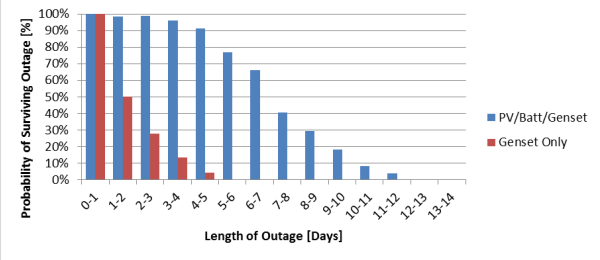How Solar PV Can Support Disaster Resiliency
Feb. 3, 2015 by Eliza Hotchkiss
When Hurricane Sandy made landfall on the east coast of the United States, New Jersey was ranked second in the country for solar photovoltaic (PV) implementation—only behind California. However, when millions of New Jerseyans were without power after the storm, only two PV systems in the state were operational.
NREL began researching existing PV systems and conducting site assessments in New Jersey following Hurricane Sandy. The challenge that New Jersey was faced with was that, despite having ample solar PV installed, the systems were non-operational due to disconnect policies and the type of control technology installed. These factors prevented PV systems from "islanding" or remaining operational even when the grid goes down.
According to a technical report released by NREL, the majority of the PV systems in New Jersey may have been able to operate during Hurricane Sandy if the state had preemptively installed islanding controls and dynamic inverters. Such steps would have allowed police dispatch centers and communication towers to operate without grid power while residents would have been able to use critical appliances and electrical devices.
Currently, the most common practice for protecting critical facilities or assets during grid outages is to use emergency back-up generators. Generators are typically fueled by diesel and run on a monthly basis for maintenance purposes. When grid power is unavailable to a site, the back-up generators are generally used to provide power until the grid is running again. This process regularly consumes fuel and creates emissions, and procurement of back-up generators generally does not prioritize fuel efficiency.
NREL conducted a microgrid analysis using the REopt model to determine the probability of surviving a grid outage using generators only, assuming a supply of diesel fuel that would last 2 days, and then modeled the same scenario using a hybrid system which added solar PV and battery storage to the generator (1.9 megawatts PV, 411 kilowatt hours/329 kilowatt battery).
The results indicate that energy supply is more secure when renewable energy and energy storage technologies are included in the grid system. The diesel fuel supply for the generator only lasted five days at most (assuming no fuel resupply) given the assigned critical energy loads. The hybrid system could provide power for up to 12 days, allowing the diesel fuel for the generator to last a greater length of time. The extended operation shown in Figure 1 depends on adequate controls for concurrent operation of these energy assets.

Figure 1. Modeled REopt Results Comparing Generator Energy Supply to a Hybrid System
Source: Travis Simpkins and Dylan Cutler, NREL
On its own, solar PV has proved to be a viable option for increasing resiliency during grid outages for more than two decades. Photovoltaic technologies have provided emergency power in the aftermath of major disasters, including:
- The Northridge Earthquake of 1994—PV kept some communications links operating and supplied power to Southern California residents that had installed systems in their homes.
- Hurricane Andrew in 1992—PV systems were used at shelters and medical clinics, to power street lights, and to power communications systems.
- Hurricane Hugo in 1989—A portable solar PV generator powered a community center for six weeks following the storm.
These PV systems were specifically designed to be islanded so they could provide power when the grid went down, thus highlighting a difference between these systems and those in New Jersey that were not designed to operate independently of the grid.
Examples of incorporating PV into energy systems designed for resiliency are popping up across the country in residential communities and private sectors, including the telecommunications industry.
- A neighborhood in the California desert city of Borrego Springs is utilizing community energy storage and 700 kW of distributed rooftop solar PV to improve energy reliability and resilience. This system is comprised of distributed generation, energy storage units, and island-enabling control technologies. It has demonstrated successful islanding and provided power during scheduled and weather-related outages.
- Rutland, Vermont, which experienced power outages during Hurricane Sandy, decided to take matters into its own hands by implementing a solar-powered microgrid. The project includes 2.5 MW of solar capacity, along with 4 MW of battery storage, which can supply electricity for approximately 365 homes.
- T-Mobile is improving the resiliency of their communications services by installing solar PV to provide backup power at cell towers across the nation. As illustrated in the REopt analysis mentioned previously, T-Mobile and Verizon are realizing that combining solar PV, batteries, and diesel can increase the length of time diesel reserves last during an emergency, and free up limited fuel supplies for other uses.
These examples, and others, are detailed in NREL's Distributed Solar PV for Electricity System Resiliency: Policy and Regulatory Considerations report.
Extreme weather events are increasing in frequency and in impact, costing billions of dollars in recovery efforts. The National Oceanic and Atmosphere Administration (NOAA) reports that there have been 170 severe weather disasters since 1980 in which overall damages reached or exceeded $1 billion. Hurricane Sandy alone resulted in an economic loss of $66 billion. As more communities, states and businesses prepare for power outages caused by high energy demand or by natural disasters, the possibilities for including renewable energy technologies like solar PV will provide more examples on best practices. The research done in this area, and the real world applications noted here, indicate that a well-designed PV system, combined with appropriate controls and energy storage are successful at increasing energy security, reliability, and resilience in the wake of a disaster.
Share

